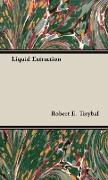- Start
- Liquid Extraction
Liquid Extraction
Angebote / Angebote:
LIQUID EXTRACTION by ROBERT E. TREYBAL. PREFACE: The unit operation, liquid extraction, has rapidly assumed major indus trial significance as a means of separating the components of solutions. Whereas simple extraction procedures have been a Omrngn and familiar laboratory practice for many years, in the technical application to large scale industrial processes a wide variety of complex flowsheets and equip ment types has been developed, the usefulness of which has not been thor oughly explored. As so frequently happens, the needs of the chemical industry have advanced much more rapidly than the accumulation of design data necessary for adequate application of these techniques. Much of the resulting confusion and possible hesitancy in applying extraction to separa tion problems can be removed by outlining its potentialities and limitations in organized form. It is sincerely hoped that this book will be of service in this respect. Relatively little instruction is given in liquid extraction in undergraduate chemical-engineering courses, and graduate courses have been developed only recently. As a consequence, many chemical engineers and chemists who must work with extraction have had little if any formal introduction to the subject. It is one of the purposes of this book to provide a text suitable not only for organized courses, but also for those who must study without benefit of guidance. To this end, the book contains many illustrative examples worked out in detail and a collection of problems for student practice. In addition, for those who may wish to investigate sources of original data, fairly complete bibliographies are appended to each chapter. In so far as it was possible a consistent notation was used throughout the book the number of mathematical symbols required was so great, however, that duplicate meanings for a few could not be avoided. The table of notation at the end of each chapter provides adequate definition of these so that there should be no confusion. It is the additional purpose of this book to set forth in logical order the known facts concerning liquid extraction and as far as possible to establish from them general principles which can be used as guides in evaluation. It would be presumptuous to suppose that, in the present early stages of technical development of the operation, this has been entirely successful there is as yet too much that is contradictory. Indeed, in the preparation of this manuscript I have been singularly impressed by the wisdom of the observation of Sir Charles Singer, the medical historian If from the facts no laws emerge, the facts themselves become an obstacle, not an aid, to scientific advance. On the other hand, if knowledge of the shortcomings of our available information leads to more logically organized research and investigation in the future, much will have been gained. The contribution of many industrial firms, technical organizations and publications, and individuals to this book have been acknowledged at ap propriate places throughout the text, but this cannot indicate the trouble to which many of them were put and the very considerable cooperation which they offered. This rather inadequate mention of their assistance is in no way indicative of my gratitude. In addition, I wish to thank J. C. Elgin, W. E. Lobo, V. S. Morello, and J. H. Rushton, who were helpful in many ways and my colleagues at New York University, T. W. Davis, John Happel, Morris Newman, and J. E. Ricci, who read and criticized portions of the manuscript. Most of all my thanks are due my wife, Gertrude I...
Folgt in ca. 15 Arbeitstagen
